SEO Trends for 2012
The wrath of Panda: In general more attention has to be paid to on page SEO, having quality fresh original content, and making sure you have a very usable, high quality, fast loading site. Gone are the days when you can slap a site together and build a bunch of links to it and expect it to rank and stay ranking. The Google Panda update sent tremors through the SEO industry and many site owners felt the bite of Panda 1 year ago when Google unleashed its furry. Sites with on page SEO issues, thin content etc, experienced large drops in rankings and site traffic. The new reality is that you have make sure your basic SEO on page factors are rock solid. Your mantra now when starting a new SEO campaign or site should be like the field of dreams: “If you build it they will come.” If you make a high quality site that is built with SEO, design, usability best practices in mind, and load the site up with high quality content that site visitors really want and appreciate when they find it, you will succeed.
Social Signals: Social signals will become more of a factor towards SEO rankings and visibility moving forward. Google plus one taking over the search results page was a real shot across the bow and clearly shows that Social signals and social search results are part of Google’s plan. Now, just having people in your circle of friends can dramatically change what you and they see in the search results. Also Google has hinted at the social signals effecting the search results themselves regardless of the personalized search results.
Here’s a little more detailed info about the infographic above
- .EDU resources- Getting links from authoritative .edu sites can really help your site’s rankings. There are different ways to do this but in general the idea is to add either a resource on your site that professors or students can use. There are other interesting methods like targeting college students in a twitter contests (got this idea from Will Reynolds of SeerInteractive). Or getting on a preferred vendor list etc for the college, they often post these on their sites for employees to be able to lookup. Also there are .edu blogs etc and certain areas of the site you might be able to add content and links etc.
- Q&A and review sites for your niche- If you can create a resource section on your site or even a subdomain or other site this can be a great source of traffic and links on your site.
- Never overlook the obvious of constantly looking for new keyword opportunities, some people think you can just do keyword research one time at the start of your SEO campaign and never work on them again. True your main keywords probably won’t change much, but a lot of your mid level and long tail keywords can change and devleop over time esp. if your industry is changing constantly. Google says that 25% of their search queries they’ve never even seen before each day, so there’s always room to find and discover new keywords in your site logs and doing keyword research to find new low hanging fruit.
- Siri Optimization- If your trying to rank locally, you should consider making sure your site is in yelp and which ever local directory Apple’s Siri voice search is using in your area for your industry, and doing what you can to rank higher in that directory.
- Broken link campaign- Searching for broken links on other people’s sites can be a great way to get a link from a site, the idea is to find an authoritative site, that has a broken link to a resource site or page, and make an equivalent resource and let the webmaster know about their broken link and your link could replace it.
- High quality blog comments- Some people claim blog commenting is dead, but if you focus on niche blogs that are authoritative and the potential to leave a thoughtful useful comment including your link, then I think it’s win win and can still help with your link graph, if nothing else at least you have some link diversity if nothing else.
- Mobile Search Optimization- Making sure you have a mobile version of your site, and are getting listed in local directories and getting links and content that target the local area are key elements to making sure mobile visitors are having a good experience and finding your site.
- Deep linking- A lot of people I’ve noticed build links almost exclusively to their home page not realizing their whole site should be optimized and have links going deep into the site to help rank other pages and spread the page rank juice around naturally.
- Social signals- Make sure you’re doing what you can to increase, the likes, shares, follows, +1′s and comments socially, making sure to have a social sharing links on your pages of your site and the basics of having a twitter account, facebook etc, and making sure to socially bookmark all your posts and content as well.
- Web 2.0 sites and profiles can be a useful way to build link diversity- Focus on building quality pages like Hub pages etc. and adding links to your target site can be a useful strategy.
- Online Press Releases- You can get some additional links to your site and also some human visitors that read your Press release, using any number of free or paid PRNewswire type services.
- Guest blog posts- Look for niche authoritative sites that are looking for writers to help them write blog posts and articles, if you search around online you can find them, write the content they like and add a link to your site in the footer or content.
- Directories- Most online website directories don’t help much with SEO, but there are some that are more useful then others that are still worth submitting your site too, often they’re paid and have editors that review the site. Sites like Business.com, Yahoo, BOTW best of the web, BBBonline, your local chamber, etc, come to mind, there are many others, and esp. finding niche directories for your industry and be very useful.
- Convert citations to live links- Do a search for “yourdomainName.com” and you’ll likely find some of the references are not hyper-linked, contact these site webmasters and request they turn the citation into a live hyperlink.
- And don’t forget to ask clients, vendors, partners, trade organizations, chambers etc. for a link.
- Content Marketing- i.e articles, guest blog posts, etc are a great way to build authoritative white hat links
- Slideshare and Document hosting- 3d party sites that you can upload say your white paper or PowerPoint with links to your site in it can be useful for links
- Link bait- i.e writing very provocative blog posts or articles on your site in the hopes of it causing people to take notice and hopefully link to and share socially is a great method.
7 Social Media & SEO Tactics Businesses
1. Social Listening for Marketing Intelligence
Last year we saw a plethora of new technology platforms that moved social media monitoring and started crunching some sophisticated data to gauge sentiment to drive marketing campaigns.In my view, 2012 will be a year where businesses will take a step forward from simply looking at company mentions, debatable “sentiments”, and arguable influencer scores, and instead move toward combining all disparate social data to form a marketing intelligence that drives future marketing campaigns. Quite a few tools are doing this already, but expect to see more.Marketers will no longer be tongue tied when asked by C-suite “mentions on social media...so what?” Instead, platforms will help marketers make smarter marketing decisions based on social listening.2. Facebook – Advertisers and Brands will Focus More on Profitability
With Facebook on pace for a billion users , playtime is over. Businesses had in the past put lot of emphasis on the somewhat superficial numbers like number of Facebook fans without taking into account the quality of that fan acquired. What we’ll see instead in 2012 is businesses focusing more on profitability and a laser-sharp ROI focus when it comes to Facebook contests, Facebook ads, and Facebook only promotion.Businesses will also realize that there is more to Facebook than measuring a linear conversion path from a fan to a paid customer. Marketers will be open to measure non-linear path of ROI measurement like creating Facebook-only promos to drive offline traffic. Retailers are a classic example, where lots of buzz and Facebook-only promotions will be done to drive foot traffic into retail stores. Besides large retailers, we’ll see an increasing number of small and medium-sized businesses adopt this strategy.Advertisers will start measuring their Facebook Ads campaigns based on profitability that either helps generate revenues or supports in some kind of cost savings. Brian Carter’s new book “The Like Economy: How Businesses Make Money with Facebook ” is an excellent resource.3. Google+ - Pedal to the Metal
Google will aggressively roll out new features to Google+ and make Google+ pages more business-friendly. The biggest advantage Google has is its integration with other Google properties, like in its search engine results pages, in paid search ads, Google Reader, YouTube, etc.Google also put a great internal focus on social last year by restructuring its employee bonus and salary structure based on Google’s success on social. This internal focus ensures that everyone inside the Googleplex thinks of social all the time. So, this internal focus with external push to consumers could make 2012 a year of Google+.4. Quality Content
We all appreciate the importance of quality content – content that is engaging, relevant, and unique to the user.Over the past few years, we’ve seen this mad rush (and budget) from companies to create content with the sole purpose of creating content for SEO. But we all know what happened to that with Google’s Panda update! So, in retrospect, Panda was a timely and much needed update from Google.Instead, what we’ll see in 2012 is a more structured approach by businesses to create content that focuses on provides unique value to readers resulting in higher engagement levels with their community members. We’ll see a more holistic approach from businesses with content, whether it’s videos, how-to content pieces, or other types of content.5. Community Building
As marketers get sophisticated with planning and measuring their campaigns, we’ll find businesses paying close attention to their existing community members. An increased emphasis will be placed on building an engaged community as opposed to simply amassing numbers. This means community managers must energize their community members as well as engage members for a variety of things like product development, market research, and special product discounts, to name a few.Community building and management is all about people, content, and consistency. This tactic will be widely adopted in 2012 and will become an integral part of community management.6. Social, Local, Mobile (SoLoMo)
SoLoMo – the social, local, and mobile triumvirate, will get a strong hold in 2012 with more integrated campaigns combining social media with local offers involving mobile devices. Essentially, socially advocated mobile content has the potential to boost brand loyalty, and this can boost sales among nearby on-the-go shoppers.Top daily deals sites like Groupon and LivingSocial are perfect examples of this where they using deals to drive local sales. Foursquare is perfectly positioned for this SoLoMo tactic. We’ll see more local merchants signing up with Foursquare.7. Social Media Drives SEO
Traditional on-page SEO factors will still hold true since it’s all about making your content search friendly, but what we’ll see in 2012 and beyond is strong social media sharing activities will drive SEO results. Last year we witnessed Google’s push to integrate social results into its SERP’s (and the newly launched Search Plus Your World update) and the Facebook-Bing partnership.Ultimately, SEO will win because conversions will be higher (and relatively straightforward to measure) on organic search. As a result, more businesses will ensure closer collaboration between their search and social teams.10 Advanced SEO Tactics That Will Increase Your Blog’s Traffic
Starting a blog is pretty simple. Actually getting people to visit it is hard. It’s not enough to just create great content and hope they will come…Because they won’t.Today’s successful blogs dig into a deep bag of tricks that include SEO, design and analytics …and then combine these elements into ever more advanced tactics that help them drive traffic to their sites, grow their audience and rank high in the search engines.Here’s a list of ten of those tactics that I’ve had great success with in the last couple of years to help you increase the traffic to your blog .Make it easy for people to find your content over the web
One of the latest developments at Google is author markup . This feature allows you to connect all of your content across the web beneath one author/bio profile.For instance, here’s what Danny Sullivan looks like on the search engine results page on a search for “SEO advice”: The image of Danny sets him apart from other SEOs, and if you click on the “by Danny Sullivan” link you land on his Google+ page:
The image of Danny sets him apart from other SEOs, and if you click on the “by Danny Sullivan” link you land on his Google+ page: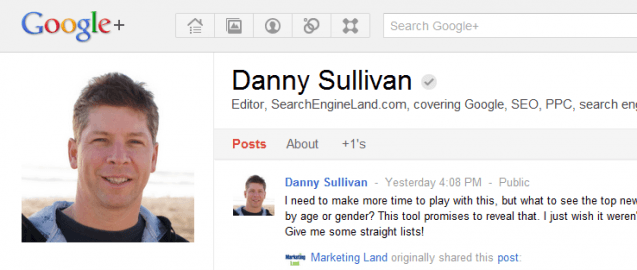 Click on the “More by Danny Sullivan” and you get a Google results page dedicated to his content:
Click on the “More by Danny Sullivan” and you get a Google results page dedicated to his content: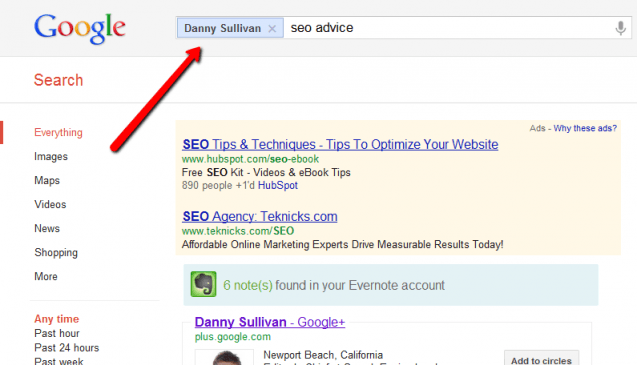 As you can see adding author markup feature to you social identity will improve your chances in search results, increasing click throughs to your content.Implementing author markup isn’t easy, however, unless you check out AJ Kohn’s guide on how to implement REL=AUTHOR . This is a great guide that AJ put together with the help of three Google engineers.
As you can see adding author markup feature to you social identity will improve your chances in search results, increasing click throughs to your content.Implementing author markup isn’t easy, however, unless you check out AJ Kohn’s guide on how to implement REL=AUTHOR . This is a great guide that AJ put together with the help of three Google engineers.Strategically join relevant audience communities
One thing about link building and SEO strategy that gets missed so often is the relationship…actually getting to know people is the bedrock to getting links.You do this by participating with your audience where they are hanging out. A really great way to make this very strategic is to use Google’ doubleclick planner .Here’s how it works. Drop in a relevant web address…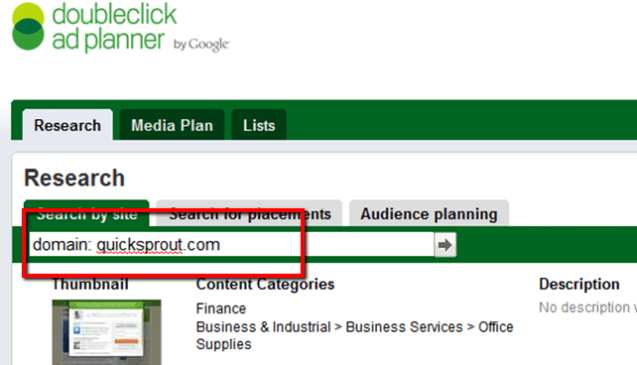 Then copy down the list of sites that it creates:
Then copy down the list of sites that it creates: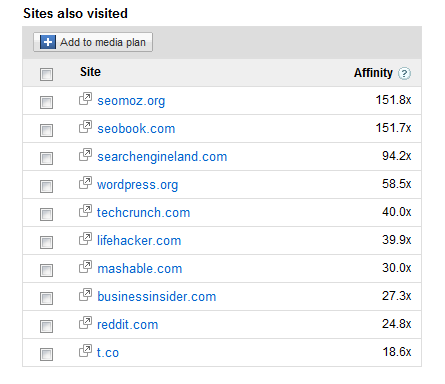 You can start at the top of that list and start visiting, reading and sharing comments on those sites. In time you will start to create relationships with some of the other readers that will lead to links and traffic.Doubleclick will also give you an idea of the typical interests of your audience (based upon the web address you enter):
You can start at the top of that list and start visiting, reading and sharing comments on those sites. In time you will start to create relationships with some of the other readers that will lead to links and traffic.Doubleclick will also give you an idea of the typical interests of your audience (based upon the web address you enter): I’ve found this list great for strategically pursuing other industries that might need my help. It’s also a great way to come up with content for guests posts .As you add value to these different communities, people will start rewarding you with links and traffic. Avoid spamming and dropping self-promotion links…the community will ignore you if you do that.
I’ve found this list great for strategically pursuing other industries that might need my help. It’s also a great way to come up with content for guests posts .As you add value to these different communities, people will start rewarding you with links and traffic. Avoid spamming and dropping self-promotion links…the community will ignore you if you do that.Use Super-Sized Images, Photos and Illustrations
Last year the 2011 Technorati State of the Blog report stated that 90 percent of bloggers share some type of media on their blogs.Photos are the most popular: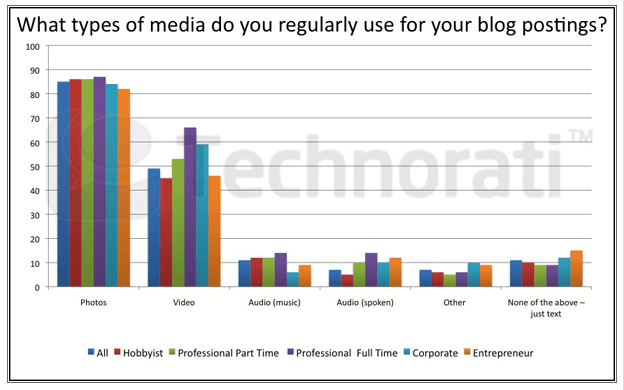 But when it comes to great blog/site design and attracting links, just sharing any old photo won’t do the trick. Besides, why not leverage the excellent resolutions of new monitors by sharing beautiful photos?This was the very point behind Boston Globe’s Big Picture blog . Every day they share some of the best photos on a certain topic. The images are big and bold…filling up at over 990 pixels wide. They are hard to ignore and got the blog picked up by Time as one of 2011’s best blogs .Now that’s a great link to have!Even though it’s been less than a year since their last redesign, Fast Company redesigned their blog so they emphasize photos and images on their site.
But when it comes to great blog/site design and attracting links, just sharing any old photo won’t do the trick. Besides, why not leverage the excellent resolutions of new monitors by sharing beautiful photos?This was the very point behind Boston Globe’s Big Picture blog . Every day they share some of the best photos on a certain topic. The images are big and bold…filling up at over 990 pixels wide. They are hard to ignore and got the blog picked up by Time as one of 2011’s best blogs .Now that’s a great link to have!Even though it’s been less than a year since their last redesign, Fast Company redesigned their blog so they emphasize photos and images on their site. It’s reviving it’s readership with these outsized photos, drawing readers and links alike. Some sites like Cabin Porn are even taking it farther by filling the entire screen. This kind of out-sized use of photos leads to new viewers and links.
It’s reviving it’s readership with these outsized photos, drawing readers and links alike. Some sites like Cabin Porn are even taking it farther by filling the entire screen. This kind of out-sized use of photos leads to new viewers and links.Think Outside of the Social Media Sharing Box
Facebook, Twitter and Google+ aren’t the only social sites that have the power to push traffic to your site. Other niche communities can do the same thing:- StumbleUpon
- deviantART
- Tumblr
- delicious
- HR.com
- Ning
- Soundcloud
- Goodreads
- Kickstarter
The idea is to go through a list of social networking sites , identify the ones that would be relevant to your industry and then systematically add value. As you build up relationships with users of those sites you’ll eventually start to gain links and followers.Working these other social sites will also help you develop content for you blog posts. Watch to see what is gaining popularity in content and discussions and then create posts that address those issues.By the way, back in December Reddit served over 2 billion page views :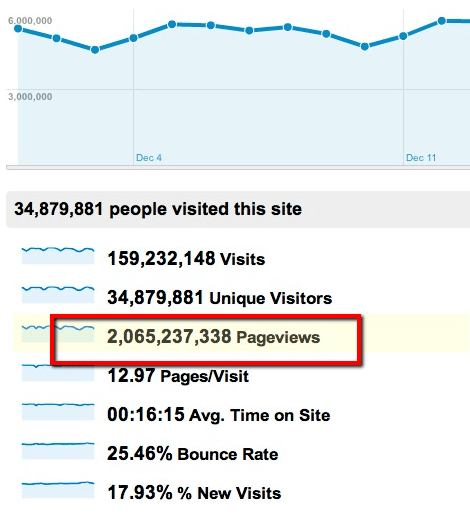 …so you should not ignore that source for an opportunity. See if there is a subreddit you should join.
…so you should not ignore that source for an opportunity. See if there is a subreddit you should join.Join Question-and-Answer Sites
People come to the web looking for answers. That’s why sites that specialize in answering questions have become popular…sites like Answers.com , Formspring , Yahoo! Answers and Quora .The best way to leverage these question-and-answer sites is to try to provide value on discussions that are important, interesting but have not had a lot of answers.Here’s one…the “best SEO strategy.”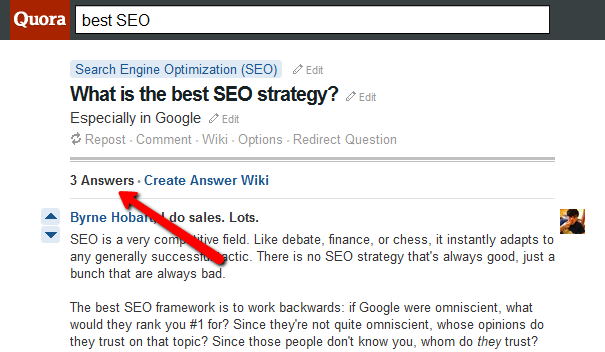 You can also look for questions that are getting a lot of attention because they are on the site’s home page, making the rounds on the social web or ranking well in search engines.When you answer in a way that provides a substantial solution to a person’s problem, providing relevant links and data, you will get the attention of anyone who is in the discussion or joins.I’ve also found that you can put links back to your site and not get called a spammer as long as they are significant to the conversation.
You can also look for questions that are getting a lot of attention because they are on the site’s home page, making the rounds on the social web or ranking well in search engines.When you answer in a way that provides a substantial solution to a person’s problem, providing relevant links and data, you will get the attention of anyone who is in the discussion or joins.I’ve also found that you can put links back to your site and not get called a spammer as long as they are significant to the conversation.Jump into Trending Discussions with Thought Leaders
There are a few sites out there that present a great opportunity for engaging readers on important issues and getting the attention of those thought leaders.As you strategically choose these sites and dive into the conversation, you could get some links and traffic as part of the process.A great example of this was when Rand Fishkin jumped on Fred Wilson’s AVC blog to disagree about a post Fred had written about marketing. Fred wrote a follow up the next day with a link back to Rand’s post .You can find the latest buzz and trending conversations by using sites like TechMeme , Topsy ,Alltop , MediaGazer and PopURLs . These are quick sites you can scan to find headlines that might be of interest to you.Design Around These 3 Crucial Elements
A lot of the things I’ve been discussing up to this point are off-page optimization and link building tactics…so now it s a good time to discuss what your site looks like and how it performs.You could spend a substantial amount of time involved in all of the above tactics, but if your site is not clean and beautiful, then you may not get the links. So you’ve got to build great, usable design.But it also needs to be fast. So, when designing your site and to make the most out of your SEO link building efforts, follow these three tips ruthlessly!- Build a beautiful web design – We are in a time where sentiment search is growing , so what a user actual thinks and feels about your site will impact rank, links and conversion. Invest in a great design!
- Site speed – This is essential. A slow site will drive traffic away. In fact, Google proved that users are much happier when search is faster. To test this they slowed down their results by as little as 400 milliseconds and reduced the number of searches by half a percent! So, evaluate your site speed .
- Important content above the fold - Research has shown that people do scroll , but more than 80% stay above the fold. Keep the critical stuff in that top 768 pixels.
Use Egobait
One of the neatest ways to measure the success of marketing blogs has been Ad Age’s Power 150 List . This is a list that ranks the top marketing blogs based on a few key KPIs. The genius behind the list is how it drives traffic back to its site, making it a very powerful link bait tool.In this particular case, the Power 150 is called “ego bait” because it appeals to the ego of those on the list. And if you are on the list, then you have the option of embedding the Power 150 badge on you site, which then…you guessed it…links back to Ad Age.That’s a very powerful SEO traffic driver.This can work for you by creating a top ten list and then offering a badge for those who make it on to the list. Write to Done’s Top Ten Blogs for Writers is a great example.
This is a list that ranks the top marketing blogs based on a few key KPIs. The genius behind the list is how it drives traffic back to its site, making it a very powerful link bait tool.In this particular case, the Power 150 is called “ego bait” because it appeals to the ego of those on the list. And if you are on the list, then you have the option of embedding the Power 150 badge on you site, which then…you guessed it…links back to Ad Age.That’s a very powerful SEO traffic driver.This can work for you by creating a top ten list and then offering a badge for those who make it on to the list. Write to Done’s Top Ten Blogs for Writers is a great example.Crawl and Validate Your Site
By the way, one of your first steps to enhancing your site and using advanced SEO tactics to drive traffic to your site is to determine where your site is by crawling and validating it.What exactly should you validate? Here’s a checklist:- HTML/XHTML
- CSS
- Accessibility (Section 508 and WAI Standards)
- Dead links
- Feeds
- Multiple browsers
- Multiple devices
Now, more importantly, how do you validate your site? Use these two tools: Crawl Tools by SEOmoz or visit the W3C validation tools . Both of these tools will help you find all the problems that need to be fixed on your site…and the priority…before you start link building.Repeat the process until you’ve got a clean site.Test, Track, Measure and Tweak to Improve Success
No campaign is complete without analytics. So all this SEO and link building work you are pouring into your site can not be improved if you don’t measure results.Here’s what you have to do at the minimum:- Google Analytics – Create an account , embed the tracking code on your site and start collecting data. Do this immediately to create a benchmark before you start any kind of campaign. Understand where you are before you try to grow. That’s your simplest measure of success.
- Webmaster Tools – Sign up for both Google and Bing webmaster tools to stay on top of the data that your site is generating. Bing may not deliver the same amount of traffic as Google, but it is sending roughly 30% of search traffic , and is likely to grow. Don’t ignore it!
- RSS Feed Analytics – More than likely you will be pushing out content through an RSS feed so make sure you are paying attention to these metrics, too. You can do this with Google Analytics .
- Browser Tests – You’ll also want to make sure that your design and the photos that you are sharing on your site are looking good across browsers. This doesn’t mean all browsers, but a general rule of thumb is to test on a browser with at least 2% market share. Chrome, Internet Explorer, Opera and Safari are all safe bets.
- Online Usability – While code analytics are great for tracking online behavior you are still left to interpret the results. With a usability test you can listen to what the user was thinking while they navigated through your site. For $40 a test, usertesting.com will give you a video of the person going through your site and typed comments about issues encountered.
You will never know if you are winning or losing if you don’t track your results. Analytics will help you learn from your mistakes, jump on new opportunities and reach your site’s fullest potential.Conclusion
Increasing traffic to your blog is an art that combines more and more advanced techniques…and as you pile up these techniques (and the links!) you will slowly grow your blog and ultimately dominate in your industry.And by the way, SEO link building is progressive and never-ending, so don’t give up if you aren’t getting the kind of results you want right away.What new and advanced SEO tactics have you been using to drive traffic to your blog?Official 12 SEO Tactics for 2012 You Must Know
As search engines and the online user community advance and mature, a fun and important to-do, is watching how the web evolves. (Not sure who’s wagging who or what). But, it’s exciting to see the changes in terms of the content, multi-media, rich applications and user experiences now available. HTML5 is coming up fast, and Flash is taking a plunge into the dirt.These changes are true across many devices, from web browsers to portable devices like smartphones and iPads. And, a prognosis by Morgan Stanley says that there will be more people using portable devices for the Internet in 5 years than there are desktop users.When it comes to search engine optimization, the trade, markets & competitors change often. Google is still the leader in search, and announced they make (on average) some 500 changes to their core algorithm. The last 12 months have been brutal on many out there. It’s for a “good cause”. (Google makes more money!)So, it’s not just about good market & technical understanding, architecture, design and content, but about ‘marketing 360′. And, do you study offline marketing and sales materials that come to your door step? (I do)It’s no longer enough to analyze, understand and apply changes in tags.The professional work is far beyond that (and has for a while). For example, spamming / stuffing keywords and cloaking is easily detected by search engines. And, professional SEOs know all this. They have applied themselves and evolved too. The ones that are lagging behind are catching up.So have the search engines, and we’ll cover some recent findings and results on what you need to do in 2012 to stay current with your website optimization practices.Industry reports, research, polls, blogs, white-papers and forums show conversations and updates about the many changes. Google themselves post updates in blogs, from their specialized products to webmastering rules and guidelines.This is important to watch and follow, but you should ultimately make sure to track your own work. Go by best practices (if I can say that), but perform your own assessments. And, if you are just tracking ranking patterns, you’d be so 2005.The top challenges for 2012 for all three types of online businesses (testing / trial category, transitional category and strategic category) are focused around building sound strategies. Findings show that ROI-based outcomes take a higher precedence than actually defining a top level strategy!This is further substantiated by MarketingSherpa and the recent SEO benchmark data: Going forward this year, you must always focus your business online with content. Add keywords and phrases to support that. And, learn to promote (not spam) more + better.
Going forward this year, you must always focus your business online with content. Add keywords and phrases to support that. And, learn to promote (not spam) more + better.And here are the 12 SEO tactics you must focus on for 2012:
(these are not in order of focus)1. Title tags2. Meta description tags3. Internal linking4. URL structure5. Keyword research6. SEO landing pages7. Digital asset optimization (video, pictures…)8. Competitor benchmarking9. Social media integration10. Blogging (different from social media)11. Link partners12. Content creation (and content marketing)The most effective and most difficult is ‘content creation’ (#12). Combine this with TITLE tags, keywords research and development & SEO landing pages, and you have the smartest tactics that will propel you forward. Of course, you need to look at them all. In fact, start with the planning & strategy to meet your objectives (you know those, right?) — then, match up the tactics and assign resources (human) to get them done.















0 comments:
Post a Comment